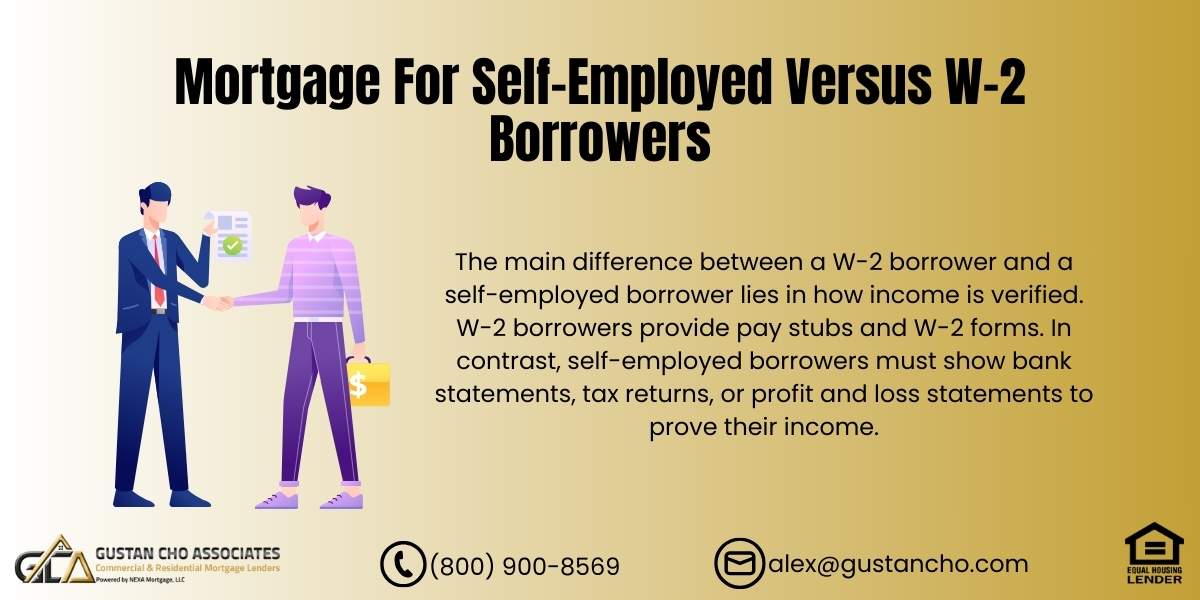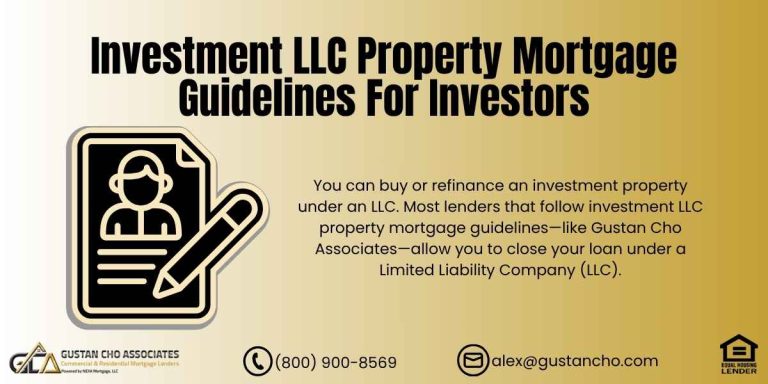Mortgage for Self-Employed Versus W-2 Borrowers: 2024 Guide to Getting Approved
Are you a self-employed worker or a W-2 employee looking for a mortgage? Purchasing a home can seem daunting, particularly when the nature of your employment influences how lenders evaluate your income. Whether you’re your boss or receive a steady paycheck, this guide will explain how to qualify for a mortgage, what lenders look for, and the best loan options in 2024. Let’s make your dream of homeownership a reality!
What’s the Difference Between Self-Employed and W-2 Borrowers?
The main difference comes down to how your income is verified.
- W-2 Borrowers: Lenders look at your W-2 forms, pay stubs, and sometimes your employer’s verification. Your income is straightforward to calculate because it’s consistent and documented.
- Self-Employed Borrowers: Since you don’t receive a traditional paycheck, lenders require additional proof of income, such as tax returns, bank statements, or profit and loss (P&L) statements.
Both groups can qualify for mortgages, but self-employed borrowers often face extra hurdles due to fluctuating income and stricter documentation requirements.
Self-Employed and Looking for a Mortgage? We Have Solutions for You!
Contact us today to learn about the best mortgage options available for self-employed individuals.
Challenges Self-Employed Borrowers Face
As a self-employed borrower, you’ve probably heard that qualifying for a mortgage is tougher. While that’s true in some cases, lenders have introduced programs specifically designed to meet your needs. However, here are the common challenges:
- Fluctuating Income: Your earnings may vary month-to-month or year-to-year, making it harder for lenders to determine your repayment ability.
- Tax Write-Offs: While deductions lower your taxable income, they can also reduce the income lenders see, potentially hurting your loan approval chances.
- Documentation Overload: Expect to provide up to two years of tax returns or detailed bank statements.
The good news? Alternative loan programs are now making it easier for self-employed borrowers to qualify!
Best Mortgage Options for Self-Employed Borrowers in 2024
Bank Statement Loans
- What They Are: These loans allow self-employed borrowers to qualify using their bank statements instead of tax returns. Lenders analyze your deposits over 12 or 24 months to calculate your income.
- Benefits:
- No tax returns are required.
- Ideal for borrowers with large tax write-offs.
- Tip: Make sure your bank deposits reflect steady business income to improve your approval odds.
Profit & Loss Statement Loans
- What They Are: These low-documentation loans require a P&L statement certified by your CPA to prove your income.
- Benefits:
- Minimal paperwork compared to traditional loans.
- Great for businesses with seasonal income.
- Tip: Ensure your CPA provides accurate, up-to-date documentation to avoid delays.
No-DTI Loans
- What They Are: The debt-to-income ratio (DTI) isn’t considered for qualification. Instead, lenders base their decisions on your credit score, assets, and down payment.
- Benefits:
- No worrying about high DTI disqualifying you.
- Tip: A larger down payment (20% or more) can strengthen your application.
DSCR Loans (Debt-Service Coverage Ratio)
- What They Are: These loans are ideal for self-employed borrowers buying investment properties. Lenders evaluate whether the property’s rental income can cover the mortgage.
- Benefits:
- No personal income verification is required.
- Streamlined approval process.
- Tip: Ensure the rental income meets or exceeds the lender’s DSCR requirements.
Best Mortgage Options for W-2 Borrowers in 2024
Conventional Loans
- What They Are: These loans are conventional options supported by Fannie Mae and Freddie Mac. They require a stable income and a strong credit history.
- Benefits:
- Low down payment options (as little as 3%).
- Competitive interest rates.
- Tip: If you have a high DTI, consider a program like Fannie Mae’s HomeReady®, which offers flexible income guidelines.
FHA Loans
- What They Are: FHA loans offered by the Federal Housing Administration are an outstanding choice for first-time homebuyers who have limited savings or lower credit scores. This program presents a fantastic opportunity to secure home financing, making it more achievable to fulfill your dream of owning a home. HUD, the parent of FHA, has set very lenient FHA guidelines on DTI.
- Benefits:
- DTI ratios up to 57% are allowed in some cases.
- Low down payment (3.5%).
- Tip: Check if your employer offers down payment assistance programs to help with upfront costs.
How Lenders Evaluate Income in 2024
Lenders use different methods to evaluate income depending on your employment type:
For W-2 Borrowers:
- Verification Documents:
- Pay stubs (last 30 days).
- W-2 forms (last two years).
- Employment verification from your employer.
- Gaps in Employment: Allowed as long as you’ve been employed with your current employer for at least six months.
For Self-Employed Borrowers:
- Verification Documents:
- Two years of tax returns.
- 12-24 months of bank statements.
- A P&L statement (optional for some programs).
- Income Stability: Lenders prefer borrowers with at least two years of stable self-employment income.
Employment Changes: What Happens If You Switch Jobs?
Your employment status greatly affects your ability to get approved for a mortgage:
W-2 to 1099:
Suppose you transition from a W-2 position to self-employment. In that case, you’ll need to establish two years of consistent self-employment income before qualifying for most loans.
1099 to W-2:
If you move from self-employment to a W-2 job, lenders can use your offer letter and first 30 days of pay stubs to calculate your income. This is a faster path to qualifying than the reverse.
W-2 Borrower or Self-Employed? Let’s Find the Right Mortgage for You!
Contact us now to get expert guidance and explore mortgage options tailored to your unique financial situation.
Debt-to-Income Ratio (DTI): A Key Factor for Both Groups
Your DTI ratio is the percentage of your income that goes towards debt payments.
- W-2 Borrowers: DTI limits are generally capped at 43% for conventional loans but may go higher for FHA or VA loans.
- Self-Employed Borrowers: Lenders calculate DTI using your net income (after deductions). This is why bank statement loans are popular—they allow lenders to use your gross deposits instead.
2024 Updates: What’s New for Borrowers?
- New Credit Scoring Models: By late 2025, lenders will implement FICO 10T and VantageScore 4.0, which better account for trends in your credit behavior. For now, maintaining a good credit score (700+) remains critical for securing the best rates.
- Digital Underwriting Tools: Lenders are increasingly using automated tools to verify income and assets, speeding up approvals for both self-employed and W-2 borrowers. Make sure your documents are easily accessible in digital format.
- Flexible Non-QM Loans:: Programs like no-ratio loans (no DTI calculation) are becoming more common, especially for self-employed borrowers with significant assets.
Tips for a Smooth Mortgage Process
- Organize Your Documents:
- Self-employed borrowers should prepare tax returns, bank statements, and P&L statements in advance. W-2 borrowers should have pay stubs and W-2s ready.
- Minimize Large Deposits:
- Avoid making large, unexplained deposits into your bank account before applying for a mortgage. Lenders may flag these as potential red flags.
- Avoid Major Financial Changes:
- Don’t switch jobs, take on new debt, or make large purchases until after closing.
- Work with an Experienced Lender:
Lenders specializing in self-employed borrowers or W-2 wage earners can tailor solutions to your unique situation.
Case Study: Self-Employed vs. W-2 Borrowers
Scenario:
- Self-Employed Borrower: Joe owns a photography business. He reports $60,000 in gross annual income but deducts $30,000 in expenses, leaving him with $30,000 in net income. Joe uses a 12-month bank statement loan to qualify for a $300,000 mortgage without relying on his tax returns.
- W-2 Borrower: Sarah is a teacher who earns an annual salary of $50,000. Because of her reliable W-2 earnings, she is eligible for a conventional loan that requires a 3% down payment.
Joe and Sarah achieve homeownership, but their paths are tailored to their employment types.
Ready to Apply? Let’s Get Started!
Whether you’re self-employed or a W-2 borrower, there’s a mortgage solution for you. In 2024, flexible loan programs and updated guidelines make homeownership more accessible than ever. Speak with a lender who understands your unique financial situation and can guide you to the best options.
Contact Us Today to start your journey toward buying or refinancing your home! Call or text 800-900-8569 or email gcho@gustancho.com. Don’t let your employment type stand in the way of your dream home.
Frequently Asked Questions About Mortgage for Self-Employed Versus W-2 Borrowers:
Q: What is the Main Difference Between a Mortgage for Self-Employed Versus W-2 Borrowers?
A: The main difference lies in how income is verified. W-2 borrowers provide pay stubs and W-2 forms. In contrast, self-employed borrowers must show bank statements, tax returns, or profit and loss statements to prove their income.
Q: Why is it Harder for Self-Employed Borrowers to Qualify for a Mortgage?
A: Self-employed borrowers often face challenges like fluctuating income, extensive documentation requirements, and tax write-offs that reduce their qualifying income in the eyes of lenders.
Q: What Mortgage Options are Best for Self-Employed Borrowers in 2024?
A: Bank statement loans, profit and loss statement loans, no-DTI loans, and DSCR loans are some of the best options for self-employed borrowers, offering flexible ways to qualify without traditional income documentation.
Q: What Documents do Self-Employed Borrowers Need to Provide?
A: Self-employed borrowers typically need to provide two years of tax returns, 12-24 months of bank statements, and potentially a CPA-certified profit and loss statement.
Q: Can I Qualify for a Mortgage if I Recently Switched from Self-Employment to a W-2 Job?
A: Yes! If you switched to a W-2 job, lenders can use your employment offer letter and 30 days of pay stubs to qualify you for a mortgage, making this a quicker path to approval.
Q: How do Tax Write-Offs Affect Self-Employed Borrowers When Applying for a Mortgage?
A: Although tax deductions decrease taxable income, they also diminish the income that lenders recognize. This can complicate the process of qualifying for a conventional mortgage unless you consider options such as bank statement loans.
Q: What’s the Debt-to-Income (DTI) Ratio Limit for Self-Employed Borrowers?
A: DTI limits are capped at around 43% for most loan types, but self-employed borrowers may qualify for bank statement loans or no-DTI loans, which don’t rely on traditional DTI calculations.
Q: Can W-2 Borrowers Qualify for a Mortgage with Gaps in Employment?
A: Yes, W-2 borrowers can still qualify if they’ve been employed with their current employer for at least six months. There’s no waiting period if the gap is less than six months, but you must provide 30 days of pay stubs.
Q: How Does Switching from W-2 to Self-Employment Affect Mortgage Approval?
A: If you’ve recently become self-employed, you’ll need to establish at least two years of self-employment income to qualify for most loans. Bank statement loans might offer a workaround for qualifying sooner.
Q: What are the Best Mortgage Options for W-2 Borrowers in 2024?
A: Conventional and FHA loans are great choices for W-2 borrowers. They provide options for low down payments and have adaptable criteria that rely on steady, verifiable income.
This blog about “Mortgage For Self-Employed Versus W-2 Borrowers” was updated on November 27th, 2024.
Looking for a Mortgage? Self-Employed or W-2, We Have Options for You!
Contact us today to discuss your mortgage options and get started on your journey to homeownership.











What about going from Self Employed to W2, I’ve been self employed as a truck driver for 20 years but sold my truck and tool a full time driving job with UPS in June. Will this work.
Hi Garrasimo,
Yes, We can definitely help you. When is the best time to talk?
For questions and concerns you may call us directly at 262-716-8151.